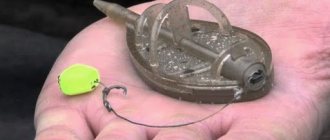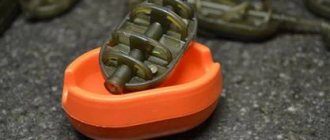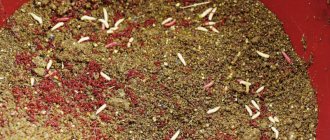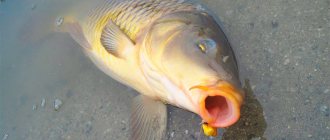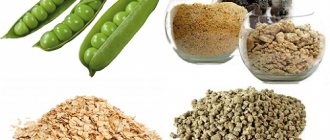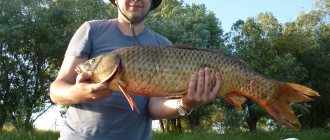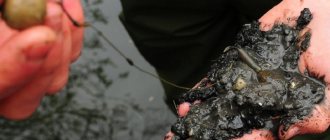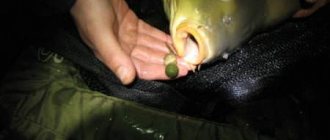What is a method feeder?
“Method” feeder - is a frame product, with a flat base created from heavy materials (to give the qualities of a sinker) and ribs, between which the bait is “stuffed”. Used only with short leashes (so that the bait is close to the bait mixture). The world's first prototype method feeder is the proud invention of match fisherman Dave Howe. However, a few years later, it was modernized by Roy Marlow (British fishing champion), officially patented and put into production. This is what we see on the shelves now.
Method equipment installation options
There are 2 main ways to use the feeder method: fixed and sliding rig. How do their mechanisms of action differ?
Fixed (blind) installation
When using a fixed method rig, a fish that grabs the bait with a hook almost immediately “feels” the weight of the feeder and self-hooking occurs (according to the “Bolt Rig” principle). It is definitely worth noting that the strength of the main line should be higher than that of the leader material. To avoid its breaking during the fishing process, which dooms the fish to certain death. She will never be able to free herself from the feeder on her own! Thus, the main line should be in the range of 8 pounds (but not less than 6 pounds), and the leader in the range of 5 pounds (but not less than 4 pounds for carp fishing). Bites can be both from the shore and to the shore.
Sliding method installation
With the sliding rig "method" - the fish begins its movement with the bait in its mouth, without feeling the resistance created by the weight of the feeder. When fishing for carp this way, you should position the rod at an angle of 45 degrees to the line and sit next to it at all times. Since bites can be sudden and very sharp! The use of durable rod stands with reliable “comeles/holders” is a must.
Advantages of installation method for feeder
Feeder equipment is understood as the connection of a feeder weight, a leash and a hook with a nozzle on a fishing line through several nodes. Its task is to achieve maximum sensitivity of the feeder tip to fish bites. You need a self-hooking effect, hide the feeder with fishing line.
One of the popular equipment is the method; it is valued for a lot of positive characteristics:
- Works in hard to reach places. This feeder installation can be safely used in silted areas and among an abundance of underwater vegetation. The whole secret lies in the flat feed tank with a wide and flat base. It does not sink into silt, and thanks to the short leashes (length 7–15 cm), the likelihood of snags is minimized.
- Masks hooks with bait. Due to the design features of the feeder, the fish does not come across a sharp sting and does not leave the fishing spot. In addition, the chances of tangling the tackle at the time of casting are very low.
- Rapid formation of a feeding spot.
- Flat-method feeders always sink to the bottom with the bait facing up, and the load is obtained from below.
- Good aerodynamic characteristics. Method feeders for feeders are distinguished by accuracy and range, operating over long distances (40–100 m).
- Possibility to adjust the amount of feed. Unlike mesh containers, in this case it is easier to regulate the volume of feed; there are no specific restrictions. For example, a good ball of bait can be placed on a feeder weighing 20 g. It will become heavier, therefore, the casting distance will increase significantly.
- With each subsequent cast, the fishing point is better fed, provoking competition among underwater inhabitants.
- No noise during the delivery of food to the fishing point, which so frightens underwater inhabitants.
- Creating a self-cutting effect. In this gear, the leash is tied tightly, so the fish has virtually no chance of getting off the hook.
- No difficulties with assembly and installation on the main conductor. To assemble the equipment with the feeder, the method only takes 5–10 minutes.
- Availability, budget.
The only negative thing you need to know about fishing using the feeder method is that it is ineffective in a strong stream. Even a beginner can assemble such equipment; here you don’t have to resort to knot fastenings at all. This explains the ease of installation and its replacement if necessary. This is especially welcome during sport fishing and when the fish are active.
What do beginners need to know?
When using method feeders, never hook a fish! She should detect herself! Frequent bites that you will definitely see are simply an attack of the fish on the bait ball itself. She rolls the feeder along the bottom - hence the many false signals. When fishing for carp using the method, you will constantly observe twitching of the rod tip. Ignore them! Wait patiently for the tip to bend powerfully. But after this, do not hook under any circumstances, but simply smoothly lift the fishing rod from the stand, and feel free to begin the process of fishing.
Feeding carp for fishing with a feeder
Catching carp on a feeder requires proper feeding of the fishing area. It all depends on the fishing distance. At a short distance, you can try to feed by hand. If you can’t reach it, then use a slingshot. Of course, this requires skill. The greater the distance, the more difficult it is to hit almost one place with a slingshot. The maximum distance for a slingshot is 60 meters. Everything further is just a feeding trough.
Or a carp rocket. If you are afraid for your fishing rod, when using a “rocket” type feeder, you can use any inexpensive and powerful fishing rod from some unknown Chinese master. If you still feed with a regular feeding trough, then the procedure should be approximately this:
We empty the first 5-6 feeders almost on the surface. Then we throw two-thirds of the bait to the point, releasing the feeder at the bottom. We leave one third for the fishing itself. If the fishing depth is not very deep, then you can later replace the feeder with just a weight. It just makes less noise when falling.
Bait for the feeder method - do it yourself
Despite the huge range of ready-made bait mixtures, most fishermen, for various reasons, prefer to make them with their own hands. Below, I have compiled a plan for making bait for a method feeder at home. In which, as it were, he answered the most exciting questions of newcomers.
Naturally, the very first question is: what is “method” bait and how does it differ from other mixtures? This is a separate type of bait, designed specifically for “filling” “method” feeders. Most often used in reservoirs (in still water) for carp fishing. A distinctive feature of this type of bait is the ability to stay securely and for a long time on the feeder.
Mixing
How to mix method bait correctly? In principle, the same as other mixtures intended for some other types of fishing with a feeder. The only difference is the consistency (i.e. the degree of thickness).
Consistency
At the moment, there are 3 main ways to achieve the desired degree of thickness:
- Mix the bait with slightly higher humidity (but not very wet), so that when “tamped” around the feeder it creates a fairly dense ball. This is necessary so that the fish will have to work hard before it can “break” it.
- Mix relatively dry bait. Only in such a way that when compressed, it is still able to form into a ball, but after casting, it begins to gradually crumble itself, forming a bait slide at the bottom.
- Divide the dry mixture into two parts, in a ratio of 1/3 - 2/3. Make most of it wet (as indicated in step 1), and the rest as indicated in step 2. Next, form a ball of wet bait around the feeder, and create a coating of drier bait on top.
What happens with option 3? Immediately after casting, the drier bait will immediately crumble (attracting passing fish with “scented paths”), and the molded ball of the wetter bait will lie exactly in the middle, then holding the fish in place.
Ingredients
In fact, this list can be endless. Below, as an example, I will show you only the most popular ingredients:
- breadcrumbs (you can buy red or brown);
- ground “classic” or carp pellets;
- whole trout/halibut pellets;
- dry milk mixtures for children;
- dry custards;
- sweet corn (chopped in a mixer or whole);
- corn (“store-bought”) flakes;
- finely chopped boilies;
- dead maggots;
- corn flour;
- hemp seed (both crushed and whole);
- “Vitalin Original Dog Food” (super food for dogs);
- fish flour.
Equipment for carp fishing using the method
In continuation of my “lecture,” especially for beginners, I suggest that you familiarize yourself with a brief overview of fishing equipment for “method” carp fishing.
Rod
In the modern assortment of “everything for fishing” products, you can easily find a wide variety of rod models designed specifically for method fishing. However, what would I advise you to pay special attention to, specifically for carp fishing? First of all, this is a rod test - it must be at least 4 ounces (113.4 g), i.e. Capable of handling line 10 lbs (4.53 kg) tensile strength or more. As well as leader materials from 4 (1.81 kg) to 8 (3.62 kg) pounds. The optimal length of a method (feeder) rod is 12 feet (3.66 meters). Build – “medium” or “slow”.
In my personal opinion, the classic version of a rod for catching carp on a “method” feeder is the “Zoo Creature Drayton Method” model from the “Leeda” brand. It consists of 4 sections with a total length of 13 feet (3.96 m). As standard, it has 2 replaceable quiver tips. Experience has shown that this rod can work well with lines in the 5-8 lb range, even despite the manufacturer's recommended breaking load of 4-7 lbs.
Stands
It is for carp fishing with a method feeder that special stands for them will be no less important than the rods themselves. Due to some similarity of this method of fishing with fishing with a “quiver tip” (shaking tip), immediately prepare yourself for the fact that the jerks will be quite powerful and completely unexpected. Thus, without using a normal stand, your rod will be in the middle of the pond in a matter of seconds.
Personally, my choice was on the Seymo adjustable carp rest, which perfectly withstands any carp attacks. You can purchase some other models, but be sure to have reliable butt holders. And don’t forget to adjust the clutch so that the fish can “take” your line.
Choosing a place to catch carp with a feeder
Despite the fact that most reservoirs have an almost flat, silted bottom, you must try to find some changes in the topography or changes in the structure of the bottom. This can be done either using a marker float or by “probing” the bottom with a weight.
Make the first maximum cast. Fix the line on the clip and begin to pull, counting the turns of the handle. Any changes in terrain will be reflected in the hand. Where there is a delay in movement, there is probably an obstacle or edge. We put a mark on the fishing line with a regular marker. Cast again and again until it hits the hand, or onto the quivertip. And so 5-6 times. If the marks approximately match, then you have found what you were looking for.
We put a regular rubber band on the spool and fix the casting distance with it. We pull out the line from under the clip, because anything can happen in the process of catching carp, but from under the elastic, the carp is able to tighten the line.
